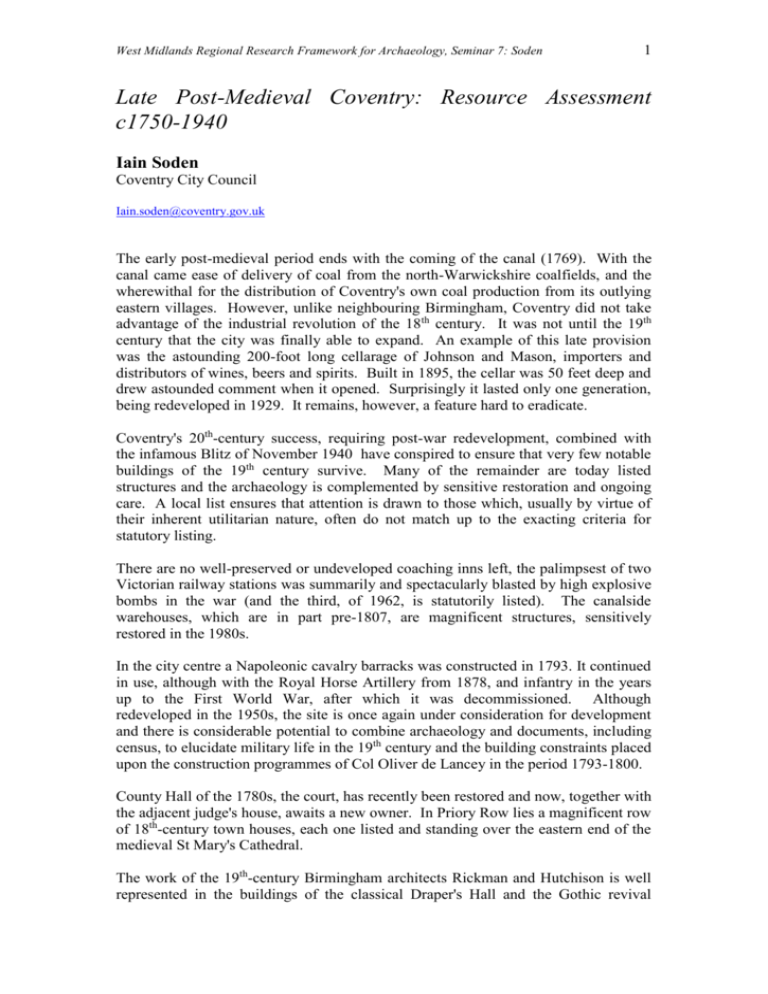EARLY POST-MEDIEVAL COVENTRY
advertisement

West Midlands Regional Research Framework for Archaeology, Seminar 7: Soden 1 Late Post-Medieval Coventry: Resource Assessment c1750-1940 Iain Soden Coventry City Council Iain.soden@coventry.gov.uk The early post-medieval period ends with the coming of the canal (1769). With the canal came ease of delivery of coal from the north-Warwickshire coalfields, and the wherewithal for the distribution of Coventry's own coal production from its outlying eastern villages. However, unlike neighbouring Birmingham, Coventry did not take advantage of the industrial revolution of the 18th century. It was not until the 19th century that the city was finally able to expand. An example of this late provision was the astounding 200-foot long cellarage of Johnson and Mason, importers and distributors of wines, beers and spirits. Built in 1895, the cellar was 50 feet deep and drew astounded comment when it opened. Surprisingly it lasted only one generation, being redeveloped in 1929. It remains, however, a feature hard to eradicate. Coventry's 20th-century success, requiring post-war redevelopment, combined with the infamous Blitz of November 1940 have conspired to ensure that very few notable buildings of the 19th century survive. Many of the remainder are today listed structures and the archaeology is complemented by sensitive restoration and ongoing care. A local list ensures that attention is drawn to those which, usually by virtue of their inherent utilitarian nature, often do not match up to the exacting criteria for statutory listing. There are no well-preserved or undeveloped coaching inns left, the palimpsest of two Victorian railway stations was summarily and spectacularly blasted by high explosive bombs in the war (and the third, of 1962, is statutorily listed). The canalside warehouses, which are in part pre-1807, are magnificent structures, sensitively restored in the 1980s. In the city centre a Napoleonic cavalry barracks was constructed in 1793. It continued in use, although with the Royal Horse Artillery from 1878, and infantry in the years up to the First World War, after which it was decommissioned. Although redeveloped in the 1950s, the site is once again under consideration for development and there is considerable potential to combine archaeology and documents, including census, to elucidate military life in the 19th century and the building constraints placed upon the construction programmes of Col Oliver de Lancey in the period 1793-1800. County Hall of the 1780s, the court, has recently been restored and now, together with the adjacent judge's house, awaits a new owner. In Priory Row lies a magnificent row of 18th-century town houses, each one listed and standing over the eastern end of the medieval St Mary's Cathedral. The work of the 19th-century Birmingham architects Rickman and Hutchison is well represented in the buildings of the classical Draper's Hall and the Gothic revival West Midlands Regional Research Framework for Archaeology, Seminar 7: Soden 2 Bond's Hospital. Both sit surrounded by arguably the most sensitive buried medieval deposits in the city. Few Chapelfields watchmakers' houses, with their characteristic middle- or top-shops survive. The same can be said for the contemporary Hillfields ribbon-weavers' houses. The survivors are generally listed buildings. Most of the grand 19th-century villas which lined roads such as Radford Road, Binley Road and Stoke Row, have been demolished and replaced with more mundane workers' housing related to the exponential growth of the city in the 19th century. A similar fate awaited the 16th-17th century farms and great houses which characterised the landowning classes of the post-Dissolution era. Archaeology alone remains to recover their plans and vestiges of their estates which were swamped by housing. However, there exist the sites of many demolished topshop buildings, particularly in Hillfields and Chapelfields, which retain the potential to further understanding of the living conditions of the watchmakers and weavers in the period 1828-1860, (the boom-years) and 1861-1914 (the decline). In the city centre a few sites of Courthousing still survive, some with their buildings preserved. The recent excavations on the churchyard of Holy Trinity Church (1999-2000) have begun to realise the potential of study into the almost modern populations of the city, lying as they do across the divide between long-lived medical barber-surgery and the aspirations of modern medicine. A total of 1706 skeletons were excavated, and although the majority (who, it must be said were very incomplete) were reburied (with full numerical coding for eventual recovery if need be) a core was sent for full analysis, benefiting from demonstrable pathologies, biographical details, and deathcertificates post-1837. A few other new cemeteries of this period still survive, such as St Peter's, Hillfields, where the early burials can be related to one industry, ribbon weaving. The massive London Road cemetery, opened in 1847, is notable for its design by William Paxton. Burials associated with non-conformist chapels of this period present an equal challenge and are largely unstudied. Making excellent use of Coventry's central location and a full array of communications links, the automotive industries flourished. However, the factories which began with sewing machines, moved on to bicycles, and thence to cars and motorbikes, made themselves targets for enemy action when they were turned over to aircraft production in World War 2; some had done so once already, in the First World War, such as Daimler which had made and flown off new aircraft from its adjacent Radford Aerodrome. At Whitley Aerodrome, built in 1918, Armstrong Whitworth made the Whitley Bomber in the early years of World War 2. After each war, despite damage, the factories were returned to their owners, leaner, fitter, often refitted or extended at the expense of the Ministry of Munitions and the Ministry of War, and their continued success was assured. Such success brought the end of the original buildings and few survive today except in plan form. Where in the late 1930s Armstrong Whitworth Aircraft were made on the World War 1 Aerodrome at Whitley (which after World War 2 continued in use as an airfield testing new technologies such as air-brakes and surface to surface missiles, are now made one of the finest of Britain's exports, Jaguar cars. The Daimler is another of many which have been totally redeveloped. West Midlands Regional Research Framework for Archaeology, Seminar 7: Soden 3 A few sites still retain their buildings, and a study was done some years ago by Ironbridge Institute, of the Coventry Car factories. The names are redolent of an ebullient Britain looking forward: Rudge, Swift, Standard, Humber, Singer, Daimler. All benefit from excellent documentation and mapping. The mines which succeeded in the 18th century were further expanded in the 19th until Walsgrave Main, Victoria, Alexandra, Craven and lastly Binley were in full production. Their respective ends came when a combination of diminishing seams, flooding and related disasters made their continuance too hazardous an enterprise. All had closed by the mid 1960s despite the last, Binley, being only in operation from after the First World War. Some of the factories and mines were accompanied by purpose-built workers' housing, in an age when the new entrepreneurs were taking a greater concern for the welfare of their staff. At Binley can be seen one of the most startling planning layouts which was erected largely in the 1920s for the miners. Not far away, in Stoke Heath, lies the village created for the Royal Ordnance Factory in the years either side of the First World War. Both contain distinctive housing in distinctive layouts. Both the village and in this case the main factory buildings still survive. Coventry's late post-medieval history has been severely affected by the depredations of the 20th century, a victim of the city's success. However enough survives for the city to make a notable contribution to the continued study of the 18th, 19th and early 20th centuries. Thus the modern city contains archaeological aspects relating to the late post medieval period as follows. These will need to be borne in mind when setting a research strategy: The canal (1769) Coaching The railway (1838) Military archaeology Silk ribbon weaving Watch-making Burial archaeology Sewing machine, cycle and car manufacture Munitions and WW1 aircraft manufacture WW1 aerodromes WW2 munitions and aircraft/military vehicle manufacture Coal mining Industrial village planning









